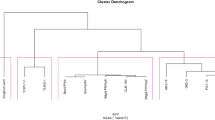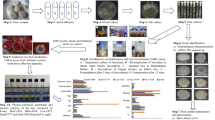Abstract
The paper was aimed to isolate a strain of Saccharomyces cerevisiae with higher alcohol, butanol. 32 strains of S. cerevisiae were isolated and identified from the dough starters from different regions. First, sterile flour solution (SFS) was developed as a substrate, and the HS-SPME-GC/MS technique was used to detect the volatile compounds, especially butanol. Then, gas production rate and acid-producing efficacy of S. cerevisiae were detected by Wickerham’s method and pH meter for assessing the ability to metabolize different sugar, respectively. Finally, pulsed-field gel electrophoresis (PFGE) was performed to determine the genetic relationships among the strains. As a result, the SC-X1 obtained the highest concentration of butanol by metabolizing SFS, and the SC-N1 produced the richest variety of flavors during fermentation. The SC-X1 had a better acid-producing ability, it metabolized glucose, sucrose and maltose to produce acid which lower the pH value by 2.26, 2.17 and 1.46, respectively. The SC-X1 had higher gas-producing efficiency by utilizing glucose and sucrose, and the SC-N1 had perfect performance in gas-producing. The PFGE similarity coefficient was high in relationship with the S. cerevisiae resource. Through comprehensive analysis, SC-X1 and SC-N1 were chosen for further research due to their excellent chemical and microbiological performances. Especially, the SC-X1 is very potential for commercial usage with high production of butanol.





Similar content being viewed by others
References
Rey-Salgueiro L, Garcia-Falcon MS, Martinez-Carballo E, Simal-Gandara J (2008) Effects of toasting procedures on the levels of polycyclic aromatic hydrocarbons in toasted bread. Food Chem 108(2):607–615
Zolfaghari MS, Ardebili SMS, Asadi GH, Larijani K (2017) Effect of Sourdough, Bakery Yeast and Sodium Bicarbonate on Volatile Compounds, and Sensory Evaluation of Lavash Bread. J Food Process Preserv 41(3):e12973
Bowen Y (2019) Variation analysis of microbial diversity in sourdough and its influence on the flavor of Chinese steamed bread, in Jiangnan University. Jiangnan University, China
Guoxun H (2016) Separation and purification of n-butanol in fermentation broth using adsorbents with different selection ratios. Zhongyuan University, Zhengzhou
Gibanel S, Prouvost B, Cleaver M, Stenson P, Pape D, Sion G (2015) Food and beverage containers and methods of coating. US, US20100068433 A1
Additives E (2016) Safety and efficacy of saturated and unsaturated aliphatic secondary alcohols, ketones and esters with esters containing secondary alcohols belonging to chemical group 5 when used as flavourings for all animal species. EFSA J 13(11):4268–4268
Zeju W (2008) Study on the identification and diversity of wine-related yeasts in Xinjiang and Gansu, in Northwest Agriculture and Forestry University. Northwest Agriculture and Forestry University, Xianyang
Bernardi TL, Pereira G, Cardoso PG, Dias ES, Schwan RF (2008) Saccharomyces cerevisiae strains associated with the production of cachaa: identification and characterization by traditional and molecular methods (pcr, pfge and mtdna-rflp). World J Microbiol Biotechnol 24(11):2705–2712
Crews C, Castle L (2007) A review of the occurrence, formation and analysis of furan in heat-processed foods. Trends Food Sci Technol 18(7):365–372
Salim-ur-Rehman AP, Piggott JR (2006) Flavour in sourdough breads: a review. Trends Food Sci Technol 17(10):557–566
Ding X, Huang J, Wu C, Zhou R (2017) Effects of different distillation patterns on main compounds of chinese luzhou -flavour raw liquors. J Inst Brew 123(3):442–451
Winkler J, Kao KC (2011) Transcriptional analysis of Lactobacillus brevis to N-butanol and ferulic acid stress responses. PLoS ONE 6(8):e21438
Hilton D, Woods KD (1986) Acetone-butanol fermentation revisited. Microbiol Rev 50(4):484–524
Li ZJ, Li HF, Bian K (2016) Microbiological characterization of traditional dough fermentation starter (Jiaozi) for steamed bread making by culture-dependent and culture-independent methods. Int J Food Microbiol 234:9–14
Vuyst LD, Vrancken G, Ravyts F, Rimaux T, Weckx S (2009) Biodiversity, ecological determinants, and metabolic exploitation of sourdough microbiota. Food Microbiol 26(7):666–675
Wu L, Wang BJ (2016) Transformation of deoxynivalenol and its acetylated derivatives in Chinese steamed bread making, as affected by pH, yeast, and steaming time. Food Chem 202:149–155
Struhl K (1985) Negative control at a distance mediates catabolite repression in yeast. Nature 317(6040):822–824
Taccari M, Aquilanti L, Polverigiani S, Osimani A, Garofalo C, Milanovi V et al (2016) Microbial diversity of type I sourdoughs prepared and back-slopped with wholemeal and refined soft (triticum aestivum) wheat flours. J Food Sci 81:M1996–M2005
Loviso CL, Libkind D (2019) Synthesis and regulation of flavor compounds derived from brewing yeast: fusel alcohols. Rev Argent Microbiol 51(4):386–397
Horstmann SW, Atzler JJ, Heitmann M, Zannini E, Arendt EK (2018) Impact of different S. cerevisiae yeast strains on gluten-free dough and bread quality parameters. Eur Food Res Technol 245(1):213–223
Ganzle MG, Loponen J, Gobbetti M (2008) Proteolysis in sourdough fermentations: mechanisms and potential for improved bread quality. Trends Food Sci Technol 19(10):513–521
Gong YX, Qi XB (2020) A study revealing volatile aroma produced by Pediococcus pentosaceus in dough fermentation. Food Sci Nutr 8(9):5077–5085
Trtkova J, Pavlicek P, Ruskova L et al (2009) Performance of optimized McRAPD in identification of 9 yeast species frequently isolated from patient samples: potential for automation. BMC Microbiol 9:234
Rodríguez ME, Infante JJ, Molina M, Rebordinos L, Cantoral JM (2011) Using RFLP-mtDNA for the rapid monitoring of the dominant inoculated yeast strain in industrial wine fermentations. Int J Food Microbiol 145(1):331–335
Garofalo C, Silvestri G, Aquilanti L, Clementi F (2010) PCR-DGGE analysis of lactic acid bacteria and yeast dynamics during the production processes of three varieties of panettone. J Appl Microbiol 105(1):243–254
Ripari V, Ganzle MG, Berardi E (2016) Evolution of sourdough microbiota in spontaneous sourdoughs started with different plant materials. Int J Food Microbiol 232:35–42
Funding
This research was supported by the fundamental research funds for China central university (Project 2662016PY102).
Author information
Authors and Affiliations
Contributions
Conceptualization and methodology, XQ; strain identification, YZ; main part in the research, NT; assistance in research and data curation, YG; writing—original draft preparation, NT and YG, as co-first author; writing—review and editing, XQ. All authors have read and agreed to the published version of the manuscript.
Corresponding authors
Ethics declarations
Conflict of interest
We are pleased to submit our manuscript to European Food Research and Technology. The manuscript has been approved by all authors for publication, and no conflicts of interest exist in the submission of this manuscript. We hereby declare that the work described is an original research that has not been published previously, and not under consideration for publication elsewhere. The authors declare that they had no competing interests.
Additional information
Publisher's Note
Springer Nature remains neutral with regard to jurisdictional claims in published maps and institutional affiliations.
Supplementary Information
Below is the link to the electronic supplementary material.
Rights and permissions
About this article
Cite this article
Gong, Y., Tumurbaatar, N., Zhou, J. et al. A strain of Saccharomyces cerevisiae with high production of butanol. Eur Food Res Technol 248, 207–217 (2022). https://doi.org/10.1007/s00217-021-03874-z
Received:
Revised:
Accepted:
Published:
Issue Date:
DOI: https://doi.org/10.1007/s00217-021-03874-z




